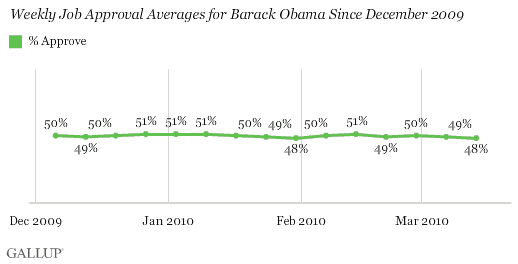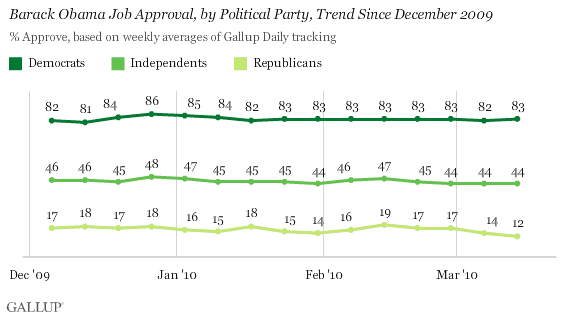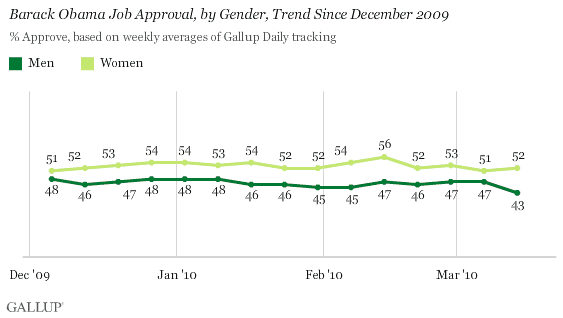PRINCETON, NJ -- At 48%, President Barack Obama's weekly job approval rating for March 8-14 ties the lowest weekly average of his administration so far. More broadly, however, Obama's ratings over the last 3 ½ months have been relatively stable.

President Obama has made passing a new healthcare reform bill his major political focus for months now, and it appears that the results of his efforts may be known this week. Democratic leaders in the House are attempting to secure the needed votes to pass a version of a healthcare reform bill by the weekend. If the legislation gets through the House, it could be passed by a simple majority vote in the Senate under the reconciliation process and be on its way to becoming law. Obama has signaled the importance of this week's actions relating to healthcare by delaying a planned overseas trip.
It is difficult to determine how much of Obama's overall approval ratings may reflect the public's reaction to his strong focus on healthcare reform.
Although Obama's current weekly average is tied for the lowest of his presidency, it is only a point or two below where it has been for months. Obama's three-day averages (reported daily on Gallup.com) have also operated in a fairly narrow range over the last 3 ½ months, ranging from 53% at several points in December and February to 46% at two points last week.
Additionally, separate Gallup research shows that Obama retains higher trust ratings on healthcare reform matters than do either Democratic or Republican leaders in Congress.
A complete in-depth look at Obama's job approval ratings, including Gallup's history of tracking presidential approval going back to the 1940s, plus detailed comparisons of Obama's ratings with ratings of all previous presidents at this point in their administrations, are available in Gallup's new Presidential Job Approval Center.
Obama Reaches New Low Among Republicans
The 12% approval rating for Obama among Republicans last week is down two points from the 14% of the previous week to the lowest Republican rating of his administration so far.

Obama's approval rating among Democrats is up a point from last week but is similar overall to what Gallup has measured among the president's own partisans for months. Since December, Obama's highest weekly average among Democrats has been 86% and his lowest 81%.
Obama's rating among independents last week was 44%, not significantly different from previous weeks.
Gender Gap Widens
Obama received a 43% approval rating among men last week, by 2 points his lowest weekly average among men to date. Obama's 52% approval among women is up by a point from last week, but is generally similar to ratings among women in previous months. The current 9-point gender gap (weekly approval average among women minus the average among men) is slightly above the 6-point average weekly gender gap Gallup has measured since Obama took office, but is not a new high -- the gap was 10 and 11 points on several occasions last year.

Bottom Line
Although President Obama's latest weekly job approval rating is technically tied for the lowest of his administration, it remains roughly in line with where it has been in recent months, and his approval rating remains slightly higher than his disapproval rating (45% last week).
This is a good news/bad news situation for the president. His ratings have not taken a dramatic hit as he has increased his involvement in the contentious battle over healthcare reform. At the same time, Obama would no doubt prefer to have solid majority approval ratings as the platform from which he makes his final push for passage of his healthcare bill.
Whatever Obama's approval ratings, the president remains more trusted on healthcare reform than either the Democratic or Republican leaders in Congress, and his 48% approval rating is well above the current 16% congressional job approval rating.
Survey Methods
Results are based on telephone interviews with a random sample of 3,596 national adults, aged 18 and older, conducted March 8-14, 2010, as part of Gallup Daily tracking. For results based on the total sample of national adults, one can say with 95% confidence that the maximum margin of sampling error is ±2 percentage points.
Interviews are conducted with respondents on land-line telephones and cellular phones.
In addition to sampling error, question wording and practical difficulties in conducting surveys can introduce error or bias into the findings of public opinion polls.
